Research
Communication and Cerebral Palsy
25 Nov 2022
Through communication, we share our thoughts and ideas, our questions and concerns, our hopes and dreams.
By Amy Hogan
Amy Hogan is the Researcher and Member Support Advisor at the Cerebral Palsy Society.
My name is Amy Hogan, and I live with Cerebral Palsy (CP) and am a wheelchair user.
I also have what could be termed as a “mild” speech impairment.
As part of my role as an advocate, it is important for me to highlight the aspects of living with CP that people may not think about, such as communication difficulties.
While I primarily communicate using speech and my voice, there are times when I find that challenging.
While most people can understand my speech in general circumstances, it took many years for me to become confident to talk in situations where I don’t know many people.
When I am excited or nervous, my vocal cords tighten as part of the spasticity. My breathing pattern becomes different and many of the words lose their clarity.
Individuals with English as their second language, crowds, and people in social settings can find listening to me a challenge.
There is also a marked difference between my speech quality in the morning and in the afternoon after work or studying for my thesis.
One aspect of my daily life that my speech impacts is the ability to use the phone, particularly when it comes to “cold calling”.
Until I was around 13 or 14, I often had my parents make such phone calls for me because I was too self-conscious about making a mistake or having to repeat myself.
Often, I find the more somebody asks me to repeat myself, the worse it gets because I’m feeling apprehensive.
However, I have gradually developed skills to deal with both my perception and other people’s challenges.
It’s an achievement in the office when I can take and manage phone calls from our general membership.
An example that is meaningful to me is the negotiation with the taxi dispatch service who I use regularly.
The primary dispatcher is a lovely man, but he struggles to understand how I say street names and numbers, particularly if they are in Te Reo or sound similar to other places.
Part of my speech is the difficulty to clearly articulate consonants, vowels, and points of emphasis, so I text him if I’m going somewhere new with the address and key information.
Technology has become an important aspect of how I navigate both my speech impairments and any psychological aspects that come from it.
I wanted to write this because raising awareness about speech and asking for compassion and understanding from the wider public is a part of advocacy.
Society expects communication to be rapid with the onset of technology. However, sometimes it is equally vital to slow down and give people the opportunity to articulate what they are trying to say whatever medium they use.
Click here for communication resources or search AAC on the My CP Guide website to find resources about Augmentative and Alternative Communication.
This article was originally published on the My CP Guide website. It was republished, with permission, in the September to December edition of The Review magazine.
For more information:
Melanie Louden
Communications Manager
melanie@cpsociety.org.nz
Mobile: 022 087 8191


